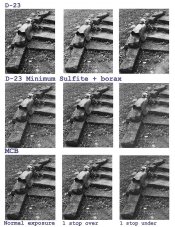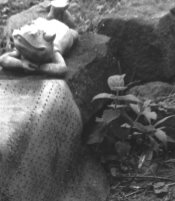dancqu
Member
Rather than the official D-23 the test was done with an
8 and 80 gram metol sodium sulfite Home Brew. Quite likely
an instrument would be needed to detect any difference twixt
the two. As some know D-23 is a much respected two ingredient
film developer. Formula 7.5 and 100 grams metol, sodium sulfite.
Film, Acros 100. Developer, 500ml of D-23 8-80 at 1:7.
Agitation, developer in and inversions to first minute.
There after 2 inversion every two minutes.
Out at 16 minutes. Temperature, 73F.
Zones 3 through 7 were exposed using a gray Sturdy Board
and blue sky. I double check zones 5 because of the usual
shutter speed change. In this case from 1/8 to 1/2 sec;
progressing from under to over exposure.
Zone densities are minus a fb+f of 0.14.
Z3, 0.42 - Z4, 0.56 - Z5, 0.66
Z5, 0.66 - Z6, 0.76 - Z7, 0.86
I thought I'd go zones 3 through 7 because by far the
greater portion of the image's content is within those 5
zones. Perhaps the curve is a little flat. A change in
agitation should do to improve. Good shadow area
contrast though. Dan
8 and 80 gram metol sodium sulfite Home Brew. Quite likely
an instrument would be needed to detect any difference twixt
the two. As some know D-23 is a much respected two ingredient
film developer. Formula 7.5 and 100 grams metol, sodium sulfite.
Film, Acros 100. Developer, 500ml of D-23 8-80 at 1:7.
Agitation, developer in and inversions to first minute.
There after 2 inversion every two minutes.
Out at 16 minutes. Temperature, 73F.
Zones 3 through 7 were exposed using a gray Sturdy Board
and blue sky. I double check zones 5 because of the usual
shutter speed change. In this case from 1/8 to 1/2 sec;
progressing from under to over exposure.
Zone densities are minus a fb+f of 0.14.
Z3, 0.42 - Z4, 0.56 - Z5, 0.66
Z5, 0.66 - Z6, 0.76 - Z7, 0.86
I thought I'd go zones 3 through 7 because by far the
greater portion of the image's content is within those 5
zones. Perhaps the curve is a little flat. A change in
agitation should do to improve. Good shadow area
contrast though. Dan













